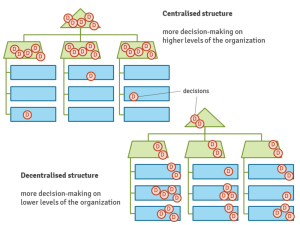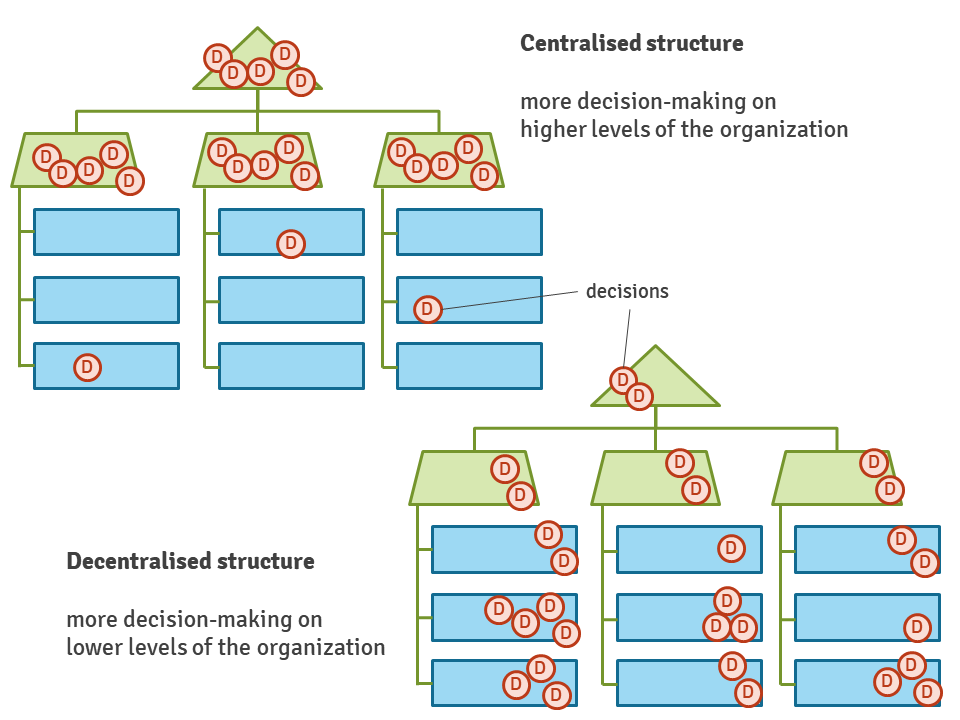Centralized organizational structure
Centralized organizational structure assigns formal decision-making powers to managers. Centralization depends on how much decision-making power is passed on to the lower levels in the organization. Centralization and decentralization are not alternative - are rather a matter of the degree of transfer of decision-making powers. It is understood that no organization is fully centralized or decentralized. You can only say that the company has a relatively centralized functions, others relatively decentralized. In theory, ideal centralized organization would have one authoritative person as manager, all-knowing and absolutely wise. This person could, therefore, take all the important decisions. The effectiveness of such organization would be the same as in the case of complete decentralization, in which each employee on the lowest level would be all-knowing and wise in his responsibility. So there is no theoretical advantage of centralization over decentralization.
The conflict between centralized organizational structure and decentralized organizational structure is reflected in the arguments against the one and the other solution.
Contents
- 1 Example of Centralized organizational structure
- 2 Arguments for centralized organizational structure
- 3 Arguments against centralized organizational structure
- 4 When to use Centralized organizational structure
- 5 Types of Centralized organizational structure
- 6 Steps of Centralized organizational structure
- 7 Advantages of Centralized organizational structure
- 8 Limitations of Centralized organizational structure
- 9 Other approaches related to Centralized organizational structure
- 10 References
Example of Centralized organizational structure
A good example of a centralized organizational structure is the military. In the military, all decision making powers are held by the top-level command, i.e., the generals. All the soldiers are expected to follow the orders given by their superiors and any decision made by the generals is binding. This structure allows for a clear chain of command and makes it easier for the military to achieve its goals and objectives.
Arguments for centralized organizational structure

Fig.1. Centralised vs decentralised organizational structure
- bright, energetic people with a knowledge are rare, there is need to concentrate power in their hands
- both large and small organizations need coordination and integration of their various activities. This is best can be achieved by a centralized authority, solving general problems.
- in large and diversified organization, various managers can think differently and focus on their own units, perhaps exaggerating their significance for the whole organization. Often overall interest organizations will require unpopular decision with which most of the staff did not agree. Only centralized management can make such decisions,
- the confidentiality of strategic plans and tactical decisions is easier to maintain if they are known by only a small group at the top.
The main benefits of centralized organizational structure are as follows:
- Clear Chain of Command: By having one centralized decision maker, there is a clear chain of command within the organization. This makes it easier for the company to communicate its goals and objectives to the employees.
- Easy to Implement: Centralized organizational structure is relatively easy to implement because it requires fewer resources and less time compared to other organizational structures.
- Higher Efficiency: By having a centralized decision maker, it increases the efficiency of the organization as decisions are made quickly and without any unnecessary delays.
- Stronger Control: Because all the decision making powers are held by the top-level management, there is a stronger control over the organization. This helps to ensure that the organization is following the right policies and procedures and that any problems are addressed quickly.
Overall, centralized organizational structure is a great option for companies that are looking to improve their efficiency and control. It is a relatively simple structure to implement and can be beneficial for achieving the company’s goals and objectives.
Arguments against centralized organizational structure
- during growth and increase of complexity of organization, leadership could not maintain centralized control. This is a physical impossibility. Because the deterioration of the quality of the central control is unavoidable, it should be logical to increase decentralization by delegation,
- decentralization gives powers in the hands of the best managers familiar with details of their products, customers and market conditions. Their guidelines, policies and procedures will therefore always be more appropriate than those made by the central authorities,
- decentralization leads to the creation of the organizational cells small enough to be known fully by managers and to identify with them. If the manager has sufficient authority, organization can benefit from the same kind of commitment and motivation, as in the case of the manager-owner.
- Shifting decision-making power down the organization will allow the participation of a greater number of people. This will increase the overall motivation and job satisfaction, and development of managers will be more effective.
When to use Centralized organizational structure
Centralized organizational structure is ideal for companies that are looking for more control and efficiency. This type of structure works best for companies that have a large number of employees and require a clear chain of command. It is also beneficial for companies that want to ensure that their policies and procedures are followed. Additionally, centralized organizational structure is ideal for companies that have short-term goals and need to make decisions quickly.
Overall, centralized organizational structure is a great option for companies that need more control, efficiency, and quick decision making. It is important to note that this type of structure might not be suitable for all companies as it may not be able to handle the complexity of certain companies or the long-term goals of others.
Types of Centralized organizational structure
- Functional Structure: This type of centralized organizational structure is organized into different departments by function. Each department is responsible for different tasks and all the decisions are made by the top-level management.
- Divisional Structure: This type of centralized organizational structure is organized into divisions. Each division is responsible for a specific product or service and all the decisions are made by the top-level management.
- Matrix Structure: This type of centralized organizational structure combines the functional and divisional structure. Each department is organized into divisions and each division is responsible for a specific product or service. All the decisions are made by the top-level management.
Overall, there are three types of centralized organizational structure: functional, divisional and matrix structure. Each has its own advantages and disadvantages and can be beneficial for achieving the company’s goals and objectives. By implementing a centralized organizational structure, companies can improve their efficiency and control and ensure that their policies and procedures are being followed.
Steps of Centralized organizational structure
- Define the Role of the Centralized Decision Maker: The first step in implementing a centralized organizational structure is to define the role of the centralized decision maker. This individual should have the authority to make decisions on behalf of the organization and should be well-versed in the organization’s policies and procedures.
- Define the Structure: After the role of the centralized decision maker has been defined, the structure of the organization should be established. This includes the chain of command, the roles and responsibilities of each level of management, and the reporting structure.
- Implement Policies and Procedures: Once the structure of the organization has been established, the company should implement policies and procedures to ensure that the organization is following the right practices. This includes setting up systems and processes for reporting, decision-making, and communication.
- Monitor Performance: Finally, the company should monitor the performance of the organization to ensure that the goals and objectives are being met. This includes tracking progress, identifying areas for improvement, and taking corrective action when necessary.
In conclusion, centralized organizational structure is a great option for companies that are looking to increase efficiency and control. It requires fewer resources and less time to implement and has several benefits such as a clear chain of command, higher efficiency, and stronger control. Implementing a centralized organizational structure requires defining the role of the centralized decision maker, defining the structure, implementing policies and procedures, and monitoring performance.
Advantages of Centralized organizational structure
Centralized organizational structure has several advantages that can help a company succeed. It provides a clear chain of command, is easy to implement, increases efficiency and provides stronger control. These advantages help companies to achieve their goals and objectives more quickly and with fewer resources. Therefore, centralized organizational structure is a great option for companies that are looking to improve their efficiency and control.
Limitations of Centralized organizational structure
Despite the many benefits of centralized organizational structure, it does have some limitations that should be considered before implementing it. These include:
- Lack of Flexibility: This type of organizational structure can be inflexible and slow to adapt to changes in the environment or in the organization.
- Not Suitable for Complex Tasks: Centralized organizational structure can be difficult to manage when dealing with complex tasks as the decision maker needs to have a deep understanding of all the different aspects of the organization in order to make the right decisions.
- Limited Opportunity for Growth: This type of structure limits the opportunity for employees to grow and develop their skills as they are restricted to a single chain of command.
In conclusion, centralized organizational structure can be a good option for certain types of companies, but it should be implemented with caution. It is important to consider the limitations of this type of structure before implementing it to ensure that it is the right fit for the organization.
- Decentralized Organizational Structure: This is the opposite of centralized organizational structure, where decision-making powers are delegated to lower-level employees. This type of structure can help to foster innovation and creativity within the organization, and can be beneficial for companies that need to be more flexible and responsive.
- Matrix Organizational Structure: This type of structure combines both centralized and decentralized organizational structures. It is characterized by a hierarchical structure with multiple layers of management, but with a greater emphasis on collaboration and communication between different departments.
- Flat Organizational Structure: This is a type of structure that eliminates the traditional hierarchy, and instead focuses on collaboration and communication between different departments. This type of structure is beneficial for companies that want to be more agile and responsive, and encourages innovation and creativity.
Overall, there are several different approaches to organizational structure, and the best option will depend on the company’s goals and objectives. Centralized organizational structure can be a beneficial approach for companies that want to improve their efficiency and control, but there are many other organizational structures that can be implemented depending on the company’s needs.
| Centralized organizational structure — recommended articles |
| Linear structure — Front line management — Levels of management — Organizational dependence — Hierarchy — Organizational systems — Hierarchical dependence — Bureaucratic leadership — Formalization |
References
- Alonso, R., Dessein, W., & Matouschek, N. (2008). When does coordination require centralization?. The American economic review, 98(1), 145-179.
- Brooke, M. Z. (1984). Centralization and autonomy: A study in organization behaviour. Praeger Publishers.
- Hage, J., & Aiken, M. (1967). Relationship of centralization to other structural properties. Administrative Science Quarterly, 72-92.
- Simon, H. A. (1954). Centralization vs. decentralization in organizing the controller's department: A research study and report (No. 4). Controllership Foundation.

